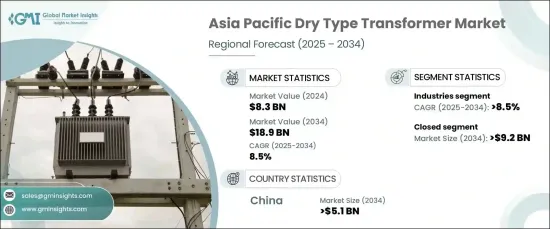PUBLISHER: Global Market Insights Inc. | PRODUCT CODE: 1667118

PUBLISHER: Global Market Insights Inc. | PRODUCT CODE: 1667118
Asia Pacific Dry Type Transformer Market Opportunity, Growth Drivers, Industry Trend Analysis, and Forecast 2025 - 2034
Asia Pacific Dry Type Transformer Market, valued at USD 8.3 billion in 2024, is poised to expand at a robust CAGR of 8.5% from 2025 to 2034. This growth can be attributed to several key factors, including rapid urbanization, large-scale infrastructure projects, and an increasing demand for energy-efficient and safer electrical systems. Unlike traditional oil-filled transformers, dry-type transformers rely on air for cooling, which significantly reduces fire risks, environmental impact, and maintenance costs. As urban areas become more congested and industrial expansion accelerates across the region, dry-type transformers are quickly emerging as the ideal solution for densely populated zones.

The region's commitment to sustainability, energy conservation, and improved environmental practices is further driving the shift toward these energy-efficient transformers. Dry-type transformers offer exceptional operational efficiency, making them suitable for a wide range of applications, particularly in locations subject to extreme weather conditions. Their ability to perform well in various climatic environments, combined with their low environmental impact, positions them as a preferred alternative to oil-cooled models in an increasingly eco-conscious world.
| Market Scope | |
|---|---|
| Start Year | 2024 |
| Forecast Year | 2025-2034 |
| Start Value | |
Table of Contents
Chapter 1 Methodology & Scope
- 1.1 Market definitions
- 1.2 Base estimates & calculations
- 1.3 Forecast calculation
- 1.4 Data sources
- 1.4.1 Primary
- 1.4.2 Secondary
- 1.4.2.1 Paid
- 1.4.2.2 Public
Chapter 2 Industry Insights
Chapter 3 Competitive landscape, 2024
Chapter 4 Market Size and Forecast, By Core, 2021 – 2034 (‘000 Units & USD Million)
Chapter 5 Market Size and Forecast, By Technology, 2021 – 2034 (‘000 Units & USD Million)
Chapter 6 Market Size and Forecast, By Insulation, 2021 – 2034 (‘000 Units & USD Million)
Chapter 7 Market Size and Forecast, By Product, 2021 – 2034 (‘000 Units & USD Million)
Chapter 8 Market Size and Forecast, By Winding, 2021 – 2034 (‘000 Units & USD Million)
Chapter 9 Market Size and Forecast, By Rating, 2021 – 2034 (‘000 Units & USD Million)
Chapter 10 Market Size and Forecast, By Mounting, 2021 – 2034 (‘000 Units & USD Million)
Chapter 11 Market Size and Forecast, By Application, 2021 – 2034 (‘000 Units & USD Million)
Chapter 12 Market Size and Forecast, By Country, 2021 – 2034 (‘000 Units & USD million)
Chapter 13 Company Profiles




